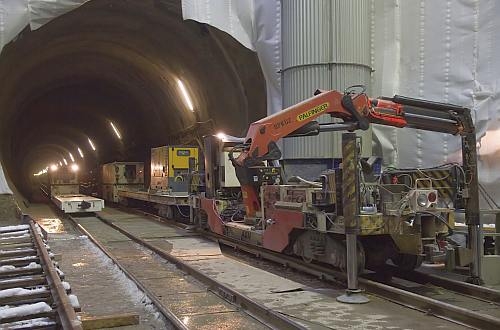Koralm tunnel
The Koralm railway is a 127 km long double-track, electrified, high-speed railway whose construction started in 2001. The entire line is expected to be finished in 2023. Some parts of the railway line are already open, or will be opened earlier, to enhance the quality of local commuter rail services. The railway is primarily built for intermodal freight transport but will also be used by passenger trains travelling at up to 250 km/h. Commissioning of the first new track section began in 2010. The centerpiece of the new railway is the Koralm Tunnel under the Koralpe mountains that give the railway its name.
Fig. 1 Overview of the Koralm tunnel

Fig 2. Boring machines in the central section of the tunnel
Austria’s longest railway tunnel
The Koralm Tunnel in the south-east of Austria is a railway tunnel that is under construction from 2009. It will link Styria and Kärnten with a total length of 32,8 km and a maximum overburden of 1,250 m will cross the Koralpe mountain. The tunnel system consists of two single tubes running in parallel with an excavation area of approx. 82 m², each capable of carrying a single railway track, which will be linked together every 500 m and an emergency station in the middle of the tunnel. It is expected to be operational by 2020 and will make it Austria's longest railway tunnel which will be a part of the 130 km long Koralm Railway and one of the world’s longest rail tunnels: only the Chunnel and the Gotthard Base Tunnel will actually be longer.
The tunnel will be built over a distance of some 12 km in keeping with the “New Austrian Tunnelling Method”. Excavation works of the pilot tunnels started in 2004. and the both tubes shall be excavated mainly with tunnel boring machines. The Koralm tunnel passes through tertiary Florian Layer, consisting of layers of sand, silt and mudstone. The tunnel crosses the disturbed crystalline outskirts of the Koralpe and passes over the sequence of foliated gneiss, mylonitic gneisses and fine grained gneiss. About 8 km to the western portal the tunnel passes fracture zone characterized by a heterogeneous structure consisting of soft-plastic, clayey disturbed rock and moderately fractured, resistant rock clods. Beside the disturbed rock masses material, the marble sequences will occur, as well as grained soft rock, fine grained sediments and poor cemented sandstone is to be expected.
Budget of several billion euros
In 2013 the Koralm railway was included into the Trans-European Transport Core Network. The project is currently the largest under way to expand the Austrian railway network with a budget of several billion euros. It will connect the federal state capitals of the adjacent states of Styria and Carinthia and reduce the travel time between Graz and Klagenfurt from 3 to 1 hour. In combination with the projected 27 km long Semmering base tunnel, the Koralm railway will remove bottlenecks in the Austrian freight and passenger railway infrastructure. It will become an integrated part of the high-speed rail link, connecting Poland (from the port city Gdańsk), the Czech Republic, Slovakia, Austria and Italy (to the city of Bologna) with each other. Together with the Italian Pontebbana railway line they will be a part of what is referred to as Baltic-Adriatic Corridor.


















































